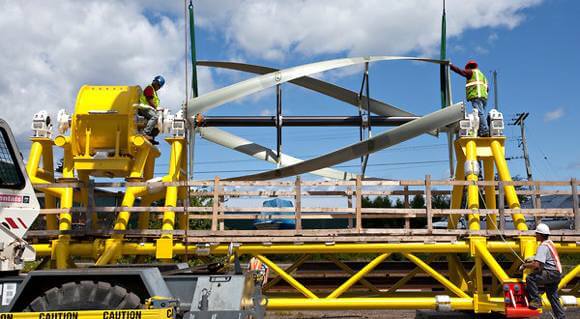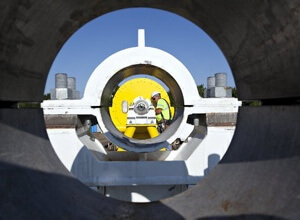
Scientists and world leaders have long sought to tap the tidal power of our world’s oceans. Now an offshore turbine has begun turning near the coast of Maine, making it the first state in the US to harness the power of the tide.
The so-called TidGen tidal turbine generator unit (TGU) was built by the Ocean Renewable Power Company (ORPC). It was installed at Cobscook Bay, part of the larger Bay of Fundy, off the coast of Maine and is accompanied by an on-shore station at Seward Neck. The peak output from TidGen is 180 kilowatts, enough to power about 25 to 30 homes. By comparison, a typical wind turbine produces about six times as much power.
The blades of the turbine, shaped like the helical strands of a DNA molecule, turn as the underwater current passes through them. Cobscook is a relatively tame part of the Bay of Fundy with current at an average 6.7 mph. The ORPC wants to make sure that the generator can handle slower waters before installing others in the Bay’s more forceful areas. The generator at Cobscook will be monitored for a year, after which, in the fall of 2013, the ORPC plans on installing two more turbines at that location. The upgrade will increase power output to 5 megawatts, which, according to the company, is enough to power 1,200 homes and businesses located in Maine. Later, they plan on installing an array of up to 18 more generators in a part of the bay where the water moves faster.
As far as tidal power goes, the Bay of Fundy is prime real-estate.
The Bay of Fundy, located east of the border between Maine and Canada, is known for its very high tides and hazardous currents. Its massive tidal flows make it one of the powerful tidal resources in the world. Each day about 100 billion tons of water moves into and out of the bay with a force of 8,000 locomotives. As powerful as the tides are, they’re also predictable, making them a force of nature that can be reliably harnessed. That’s very different from solar and wind power, both of which are dependent on our capricious weather. Another advantage of underwater turbines is that, well, they’re underwater. They won’t be a churning eye sore, which is a big problem that wind turbines face. The following is a video of what a turbine at work would look like.
As the turbine goes online, it creates a new energy asset class as power produced from the turbine is sold to the grid. The Maine Public Utilities Commission has signed an agreement to buy power generated from the turbine for the next 20 years.
Two more generator banks are planned to tap the Bay’s energy; one will be installed at Kendall Head, the other at Western Passage. Once up and running these generators and the one at Cobscook will feed electricity to the New England power pool. The whole project is expected to be completed in 2016.
With the turbine, the US joins a small number of countries attempting to augment their energy supply with water power. The UK, Norway and Scotland already have turbines installed off their shores. This past June Scottish Power installed a turbine off the Sound of Islay. With its 30-meter fins spans, the Scottish tubine looks more like a wind turbine than the egg beater the US installed. Like the US, if it runs as expected others will be installed in the near future.
Not everyone is in a huge rush to build these underwater power mills. One question that needs to be answered is how they will affect sea life. As tidal turbines are so new and rare, nothing is known about how dolphins, killer whales, seals and other large sea animals will react to them. A study is currently being performed by the prosaically-named University of the Highlands and Islands to assess how these valued creatures will coexist with the churning of underwater blades. Many eyes across the world will no doubt be waiting for the study’s results.

The ORPC has been tapping the Bay of Fundy’s powerful tides to generate electricity since 2008, but with the use of dams. When they began beta testing their TidGen Power System in 2010, it became the largest ocean energy generator deployed by the US. Alternative energies is also a priority for the state. Gerry Chasse, Bangor Hydro’s President and COO, commented in a press release, “ORPC’s project is instrumental in developing a technology that will help the state of Maine reach its goals related to fossil fuel dependency.”
Chasse’s comments reflects a larger US strategy to adopt tidal power as one of its alternative energies. The Department of Energy footed nearly half the bill for the TidGen, giving $10 million toward the project’s $21 million total cost.
A key to making our energy consumption sustainable is finding ways to harness previously untapped resources. Government-funded projects like this one could lead us to a more sustainable future.



